Need help navigating retrofits?
Register for free today!
Heat Pump Retrofit Guide: For Strata and Co-op Buildings (November 2022)
This summary guide provides advice for residents of strata and co-op buildings interested in upgrading their current heating system to an air source heat pump system.
Here you will learn about heat pumps and their benefits and find advice for planning and organizing a ground oriented or low-rise multi-unit residential building heat pump retrofit projects.
What is a Heat Pump?
Space heating consumes most of the energy used in our homes and is a significant contributor to greenhouse gas emissions. A heat pump is a highly efficient, climate-friendly, and modern alternative to a gas, oil or electric furnace or baseboard heating system, with the added benefit of included air conditioning.
A heat pump extracts heat from the outside air and transfers this heat into the inside by compressing and expanding refrigerant when heating. If cooling, the heat pump works in the opposite direction.
- A central ducted heat pump uses ductwork and a central air handler to circulate warmed or cooled air through the home.
- A ductless heat pump distributes heating and cooling via indoor heads connected to the outdoor unit with thin refrigerant lines to each head.
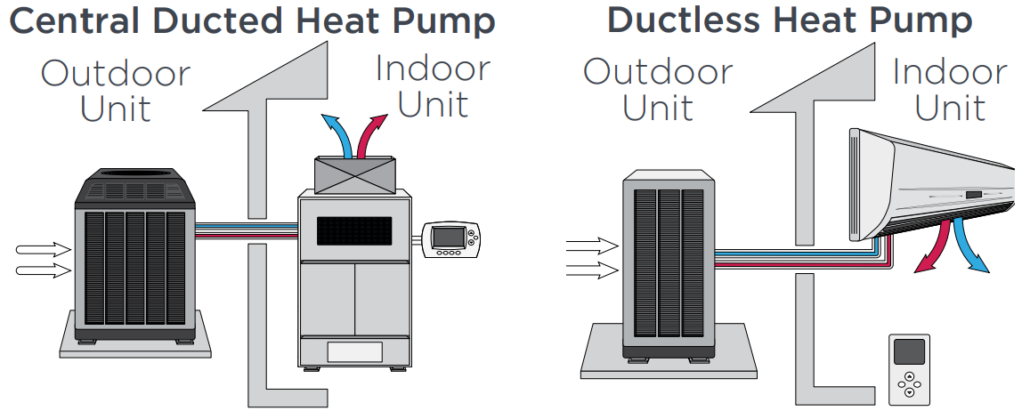
What are the benefits of a Heat Pump?
Heating and cooling in one
Make your buildings more comfortable and resilient. Enjoy energy-efficient heating in the winter and cooling in the summer.
Climate-friendly
A clean energy alternative to gas, oil or wood heating that can reduce your space heating carbon footprint by over 90%.
Maximum efficiency
The most energy-efficient heating system currently available. Up to 3 to 4 times more efficient than other electric or gas heating systems.
9 Steps to a Successful Heat Pump Install
- Establish a Building Lead
- Assess By-Laws & Regulations for Alterations to Strata or Co-op Property
- Build Awareness Among Residents
- Learn About Available Rebates
- Consider Complementary Retrofits
- Hire the Right Contractor
- Select the Right Quote
- Enjoy and Maintain Your System
- Access Support and Resources
1. Establish a Building Lead
It will be important to have designated representatives to lead the retrofit for the building. This could be a committee or an individual lead. The lead will be responsible for securing permission for the retrofit, communications with the contractor, keeping building residents informed on the retrofit’s progress, establishing installation times, confirming successful completion of work, and approval of payments.

2. Assess By-Laws & Regulations for Alterations to Strata or Co-op Property
Prior to proceeding with a heat pump installation, it is important proper steps are taken to obtain approval and to ensure that alterations will not negatively impact the building or occupants. This will include investigating the building by-laws and regulations to determine if they need to be revised or updated to enable heat pump retrofits. Watch the short video 10 Tips for Heat Pump By-laws for Stratas for ideas. You may need to consult with a lawyer to update by-laws and regulations.
The installation of a heat pump will generally also require written permission from the strata or coop before initiating with any alterations to the building. See the Condominium and Homeowners’ Association document “Contracts Relating to Alterations to a Strata Lot or Common Property” for additional details.
In the planning stages, thoughtful planning can allow you to avoid the potential for negative impacts. A qualified contractor should be able to provide guidance on these items but it’s helpful to know what to ask for:
Visual
Ensure thoughtful placement of the outdoor units. Consider using shrubs or other visual screens, which will not block air flow, if aesthetics is a concern.
Noise
If having a quiet heat pump is important, ask for quotes for quiet heat pump models. Request best practices for heat pump installation, including locating the outdoor unit in the best location and installing vibration dampening feet.
Building envelope
Ask how the envelope penetrations for refrigerant lines and electrical will be sealed.
Electrical capacity
Have an electrical assessment of the building prior to installing heat pumps. If you are switching from electric baseboards this may not be a necessity, since heat pumps will draw less power than baseboards and/or some baseboards can be disconnected. Note: If you are planning for the installation of an EV charging station in the next few years inform the person conducting your electrical assessment as it may be more cost effective to upgrade your electrical for both a heat pump and an EV charging station.
Safety
Install heat pump outdoor units where condensate line does not outflow water on to a sidewalk or other areas to avoid a slipping hazard in cold weather. Outdoor heat pump units installed on balconies should be located as far from railings as possible. If within proximity to a balcony, the unit may need to be raised on a stand to be level height with the railing to prevent climbing. Ask your contactor if your municipality has specific requirements for heat pump installations on balconies.


3. Build Awareness Among Residents
Building awareness among residents about the benefits of a heat pump retrofit can build the interest and motivation needed to advance with the retrofit. The Access Supports and Resources section of this guide provides a list of materials to help build understanding and awareness.
- Provide information about what a heat pump is, how they work, and their many benefits.
- Share heat pump case studies and testimonials.
- Plan or encourage occupants to attend a heat pump focused educational event.
- Consider the installation of a heat pump in a common area or a ‘pilot’ residential unit to test out the technology (and contractor), and provide residents with the opportunity to experience a heat pump first-hand, prior to starting a larger retrofit project.
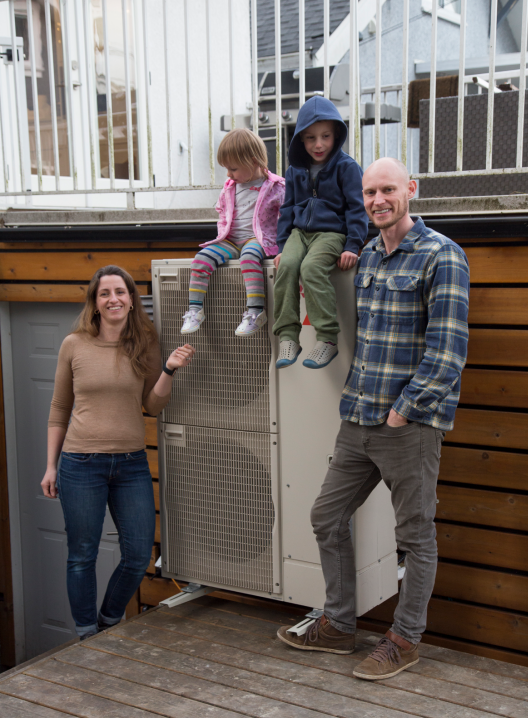
4. Learn About Available Rebates
There are several rebate programs available depending on your building type, to financially support the installation of heat pumps. For information about rebates and support determining if there are rebates available for your building contact a CleanBC Energy Coach at ask@betterhomesbc.ca, 1.844.881.9790 or betterhomesbc.ca/connect.
Single Family Dwellings & Duplexes

Side-By-Side Town Homes & Row Homes

Condominiums & Apartments: Multi-Unit Residential Building
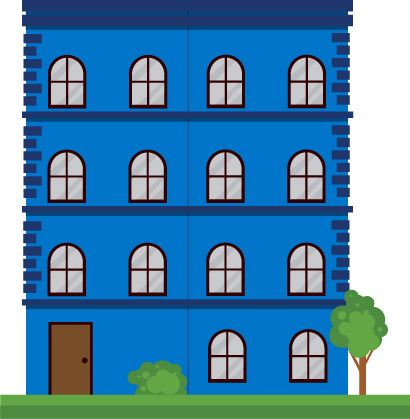
5. Consider Complementary Retrofits
Consider complementary building retrofits either before or at the same time as your heat pump retrofit. For older, less efficient homes and buildings, investments in air sealing, insulation and new windows can help reduce energy bills, and may reduce the size of the heat pump(s) needed to heat and cool the building. In some buildings, cost or other factors may limit other retrofits and a heat pump retrofit may still be the best option for climate-friendly heating and cooling, and to improve the efficiency of the building. For more information about how multiple retrofits can improve a building see the CleanBC Better Homes FAQs (Category: House As a System). For information on rebates for other retrofits see the CleanBC Better Homes Rebate Search Tool.
6. Hire the Right Contractor
Key to a successful heat pump installation is finding a qualified and experienced contractor. The best place to start is to find a registered contractor on the CleanBC Better Homes website. Heat Pump contractors listed on this website are Home Performance Contractor Network vetted to confirm they have a valid business license, liability insurance, covered by WorkSafeBC, and operate under a Code of Conduct.
Before randomly selecting from an online list of contractors, do some research. Ask for recommendations from colleagues, family or friends. Do online research by checking their Better Business Bureau rating and Google Reviews. A wise strategy for larger retrofit projects is to issue a Request for Quote (RFQ), aiming to access quotes from 2 to 3 contractors and selecting one contractor to install all heat pumps. Use an RFQ to request information on:
The heat pump system specifications
Brand name, model numbers, AHRI certificate numbers, SEER, HSPF, COP, outdoor noise decibels (dB), indoor noise (dB), outdoor operation temperature, installation costs for equipment and labour, and warranty details.
Prices for different system options
Residents of different units may want different sized systems to meet their heating and cooling needs (i.e. some units may only want one mini-split heat pump head and other units may want two or three).
Discounts
Some companies offer discounts for installations of large numbers of systems in one location. Ask contractors what discounts they may be able to offer.
Compliance with city permitting requirements
Confirmation on any permit costs and compliance with any city regulations or by-laws (placement of outdoor units in yards, noise levels, installation on balconies, etc.)
Sub-contractor coordination
Some heat pump installers coordinate hiring subcontractors. Confirm if the contractors you are accessing quotes from arrange this or if subcontractors need to be hired and coordinated separately. Sub-contact work may include:
- Electrical upgrades: Request an electrical capacity assessment at the building and unit level to identify any electrical upgrade needs and the estimated cost. If an electrical upgrade is required and not included with heat pump quote, it is recommended that the building solicit at least two quotes for electrical upgrade work.
- Other repairs: For drywall repair and painting.
Installation details
The cost of heat pump retrofits can be variable based on the installation quality. This can include whether or not the contractor will follow heat pump installation best practices guidelines. Ask your contractor to provide details on the installation and if they are willing to provide a best practices checklist and/or commissioning report to ensure the heat pumps are properly installed.
Budget holdback
Consider requesting for a percentage of the total install cost to be held back, subject to a final inspection for quality control at the end of a project.
7. Select the Right Quote
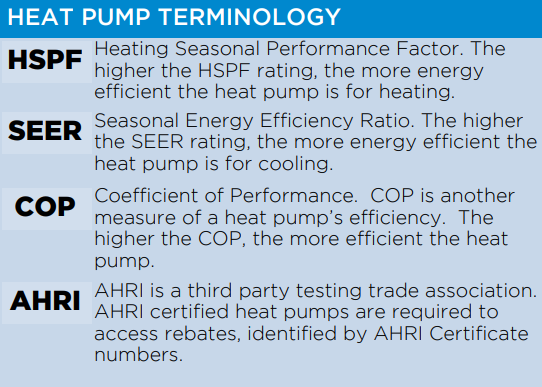
Once you have received quotes, selecting the right contractor and heat pump for your building depends on several factors. Larger retrofits projects may want to establish an ad-hoc small committee to review quotes and decide on contractors.
Is the quote complete and informative
Has the contractor provided all of the information requested to make an informed decision, or as requested in the RFQ?
Attention to aesthetics
Consider if clear answers have been provided to questions such as:
- Has the contractor effectively communicated with you about how the heat pump installations will be integrated into the building?
- Where will the heat pumps outdoor units be installed and where will the refrigerant lines run across the building. Is this plan aesthetically acceptable?
- For ductless wall mounted indoor units – has the contractor planned to install the units in a location that is most appropriate for distributing heat? Will the placement of the indoor units and their refrigerant lines be aesthetically acceptable for the occupants?
Compare offers
Compare all the information in the provided quotes to understand the difference between the heat pump products suggested by contactors.
- Consider establishing a matrix of evaluation criteria, such as pricing (after rebates), contractor experience, efficiency of system, noise rating, installation best practices, allowance for hold back, proposed installation date and results of references.
Price versus quality
Price is important but remember that the least cost estimate may, or may not, be the right system for your building.
- Less expensive systems may be less efficient and cost more on your utility bills, be louder, or not have the same level of installation quality. On the other hand, less expensive systems may be comparable in efficiency and noise rating, and represent good value to the building residents.
- If an estimate is beyond your budget, or does not represent good value, looking for a lower cost option is a good idea. Be sure not to compromise by selecting a contractor whose lower price is based on a lower quality installation.
- Is the contractor willing to provide a best practices installation checklist and/or commissioning report?
- Are bulk discounts available?
- Is the contractor allowing for a hold back on payment until after the installation is complete and inspected?
Warranty details
Warranties on parts and labour can vary significantly and may impact costs. Take the warranty into consideration when making a decision on which contractor to work with.
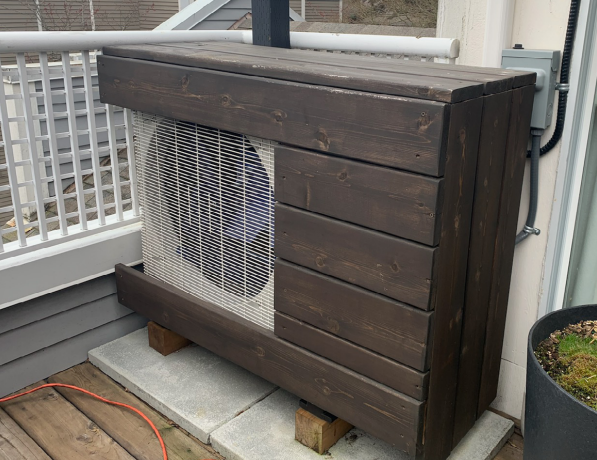
Comparing the efficiency rating of heat pumps
The long-term operating costs and efficiency of your heat pump will be partially based on the efficiency of the systems your building purchases (the efficiency of your building and the price of electricity will be the other factors).
- Heating Season Performance Factor (HSPF). The efficiency rating for the heat pump when in heating mode; an important efficiency metric because in BC we heat our homes for a larger portion of the year.
- HSPF 8.5 and under: Lower efficiency.
- HSPF 9.3 and above: Efficient. CleanBC rebate eligible province wide.
- HSPF 10 and above: Very efficient. Canada Greener Homes and CleanBC rebate eligible.
- Some systems have certified HSPFs as high as 13, a general recommendation is to buy the most efficient system you can afford.
- Seasonal Energy Efficiency Ratio (SEER). The efficiency rating for the heat pump in cooling mode. The amount of cooling a home may need will vary on the location of the home, design, exposure to sun, efficiency of the home and the preferences of the owners. For homes where there are higher anticipated cooling needs, it is recommended to purchase a heat pump with a higher SEER rating.
- SEER under 16: Lower efficiency.
- SEER 16 to 20: Efficient. CleanBC rebate eligible province wide.
- SEER 21+: Super-efficient. Canada Greener Homes and CleanBC rebate eligible province wide.
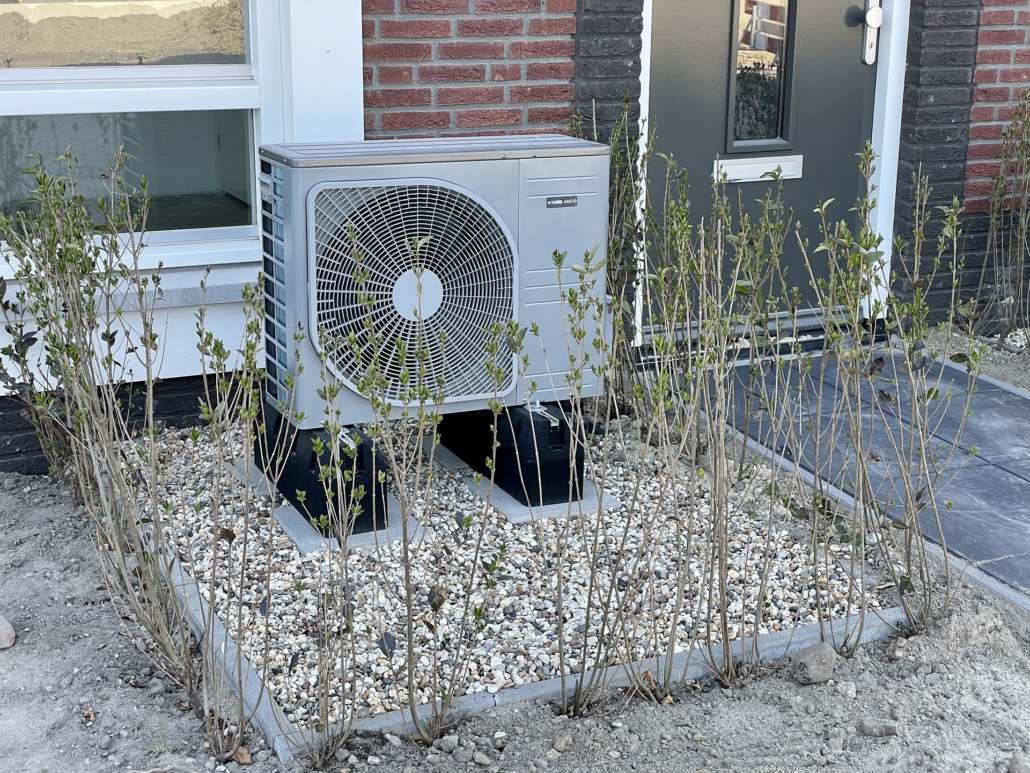
Rebate eligibility
Rebates can significantly reduce the purchase cost of a heat pump. Depending on the type of building, what type and fuel source (gas, electric, oil) of heating system in the units prior to the retrofit, and the efficiency of the heat pump being installed your project may, or may not, be eligible for federal, provincial and municipal rebates. Even if your retrofit project is not eligible for all rebates, or any rebates, a heat pump may still be the best option.
Purchase a quiet heat pump
Both the outdoor and indoor units of heat pumps make some sound. Sound is measured in decibels (dB). Average outdoor unit sound ranges from 40 to 60+ dB and indoor units range from 18 to 30 dB. If having a quiet heat pump system is important, request that your contractor provide quotes for a quiet system. Be aware, 60dB will sound twice as loud as 50dB, so even a couple of dB can matter. For comparison, normal conversation is 50 dB, while 40 dB would be a quiet library.
- If having a quiet heat pump is important for your building select the quietest model heat pumps and the contactor who provides the best installation plan for quiet systems.
- To identify a quiet heat pump – request quotes for high efficiency heat pumps with variable speed and inverter technology with a low decibel rating for both the indoor and outdoor unit.
- Confirm the contractor will install the outdoor unit in an appropriate location on a level and solid surface (i.e. sold concrete pad rather than directly on a wooden deck) with high quality vibration pads for sound dampening.
- Consider the best location for the outdoor unit. For example, place the outdoor unit as far as possible from neighbours and not right below or in front of bedroom windows. If there are areas around the building that are already noisy this may be a good area for the heat pump (i.e. near parking areas, in front of the building, or closer to busy streets).
- Fences or shrubbery, existing or planted after the installation, can provide both visual and noise barriers for the outdoor unit.
- For more information on quiet heat pump installations see the City of Vancouver’s Heat Pumps & Noise Guide.

Sealing penetrations in building envelope
Heat pump installations require a penetration (~2.5 inches in diameter) to be cut through the exterior wall for refrigerant, condensation and electrical lines. When building penetrations are protected by overhead cover, and professionally sealed, there should be no risk of rain or moisture infiltration. Confirm with your contactor how they will be sealing penetrations. Best practice recommendations include:
- Penetration is located under shelter (i.e. balcony or roof overhang).
- The penetration is accessible and sealed from both sides (moisture should not be able to enter the wall from exterior or interior).
- Penetration covered with lineset outdoor heat cap.
- Heat cap is silicone-sealed to exterior siding to prevent moisture entry.
- For buildings that want additional third-party verification of building envelope
sealing, they can hire a building envelope engineer.
Proper heat pump sizing
Ensuring that the right size of heat pump is installed will improve the performance, operating costs and longevity of the system. In many instances, to save time and costs, contractors use informal approximations, which may be inaccurate, to estimate the size of a heat pump.
- Have your contractor confirm whether or not they have completed a formal heat load calculation, or require it to be a formal part of your RFQ.
- The best way to determine the right size is for your contractor to perform a ‘heat load calculation’ which considers all the factors and provides clearly calculated information to ensure the heat pump is sized appropriately to heat and cool the home.
Beware of misleading sale tactics
If you are upgrading from a standard gas or electric furnace, or electric baseboards, be wary of contractors who try to steer you away from heat pumps. For most buildings, in milder climates like the Lower Mainland and Vancouver Island, an efficient and properly sized heat pump is typically capable of meeting all your home’s space heating and cooling needs in one system without the need for additional systems like furnaces. If the building is energy inefficient look for complementary retrofit options (air sealing, insulation, window retrofits) to improve the efficiency of the building first.
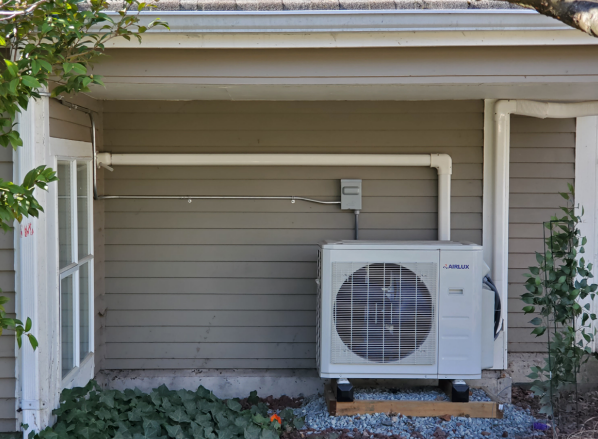
Example outdoor unit installation: Heat pump installed in an underutilized location with plenty of air flow. Unit is raised off the ground, level and with vibration pads on feet. White lineset covers match trim of building. Exterior to interior penetrations are weather protected (under eve) and appropriately sealed.
8. Enjoy and Maintain Your System

After installing a heat pump, residents will enjoy an efficient and climate-friendly heating and cooling in one system all year round. Keep in mind these points for your new heat pump:
- Utility billing will change. Converting from an electrical furnace or baseboards will see a decrease in electricity consumption and a reduced electrical bill. If the home is converting from gas to a heat pump, your electricity bill will increase, and to compensate, your gas bill will decrease. Purchasing a high-efficiency heat pump and completing complementary retrofits will help offset increases in electrical bills.
- The feel of the heat will change with a heat pump. Heat pumps produce a consistent warmth but may require more time to reach your preferred set temperatures on the coldest days.
- In very cold weather, set your heat pump thermostat to a comfortable temperature then let it be so it can run most efficiently. Setting daytime and nighttime temperatures that are different (i.e. lowering the thermostat more than two degrees lower) in very cold weather can negatively impact your heat pump’s efficiency.
- Use the thermostat ‘Heat’ or ‘Cool’ mode rather than ‘Auto’ temperature setting to avoid unnecessary switch overs.
- If you have installed a central system with back-up heating (electric or gas), only use the back-up when needed. Set all back-up system thermostats 5°C below your heat pump thermostat setting to ensure your heat pump is the primary heating source and only use the back-up when needed.
- Ensure good air flow and reduce equipment wear and tear by keeping the outdoor unit clean and clear of debris and snow. Ensure nothing is blocking the air distribution of indoor units.
- Conduct regular maintenance to maximize system efficiency. Clean units, replace or clean filters, check remote control batteries, and schedule annual maintenance with a qualified technician.
9. Access Support and Resources
Heat Pump Information
- BC Hydro’s What is a Heat Pump – Resources and videos covering heat pump basics.
- Heat Pump Consumer Guides – Consumer Guides from the Home Energy Navigator Program provide an overview of how heat pumps work, their benefits, and other useful information. Great for introducing residents to heat pumps.
- Heat Pumps and Noise – A guide by the City of Vancouver, covering heat pump noise and local considerations for placement, by-laws, and guidance on installing quiet units.
- So You Want to Buy a Heat Pump? – Insider tips for homeowners from the Building to Electricification Coalition.
- What to Expect when Upgrading to a Heat Pump – An overview of the best practices when purchasing a heat pump and post-installation expectations.
- Heat Pump Best Practices Installation Guide for Existing Homes – This contractor-focused guide by the Home Performance Stakeholder Council provides steps of a best practices heat pump installation.
- Heat Pump Installation Checklist – Print-friendly tools developed by the Home Performance Stakeholder Council
- Heat Pump Commissioning Report – Print-friendly report template developed by the
Home Performance Stakeholder Council. - Job Site Survey Checklist – Print-friendly tool developed by the Home Performance Stakeholder Council.
Strata and Co-op Heat Pump Retrofit Resources
- Heat Pump Retrofits Case Study – A case study looking at the heat pump retrofit success story of the H.W. Flesher Housing Co-op in Vancouver, BC, Canada.
- Alterations to Strata Lot Property Video – Air Conditioners – Condominium Home Owners Association of BC (CHOA BC).
- Top 10 Tips for Heat Pump By-laws for Stratas Video – A helpful video that covers many of the most common questions and processes needed for heat pumps in strata buildings provided by the Vancouver Island Strata Owners Association.
- Contracts Relating to Alterations to a Strata Lot or Common Property – Guidance regarding alterations in the context of by-laws created by CHOA BC.
- Strata Housing Resources – Resources provided by the Province BC covering basic strata information, including by-law and rules guidance.
Rebate and Grant Resources
- Register with the Home Energy Navigator Program to learn if a heat pump is right for your strata.
- CleanBC Energy Coach Service – Free energy coaching support for information on rebates and questions about heat pumps and other retrofits.
- Residential Rebate Search Tool – Search tool to find rebates and incentives for your residential upgrades.
- Commercial Incentive Search Tool – Search tool to find rebates and incentives for your commercial upgrades.
- Contractor Search Tool – Find a registered heat pump, insulation or window contractor.
- Hiring a Contractor FAQs (Category: Contractor FAQs) – Guidance on what to consider when hiring a contractor.

